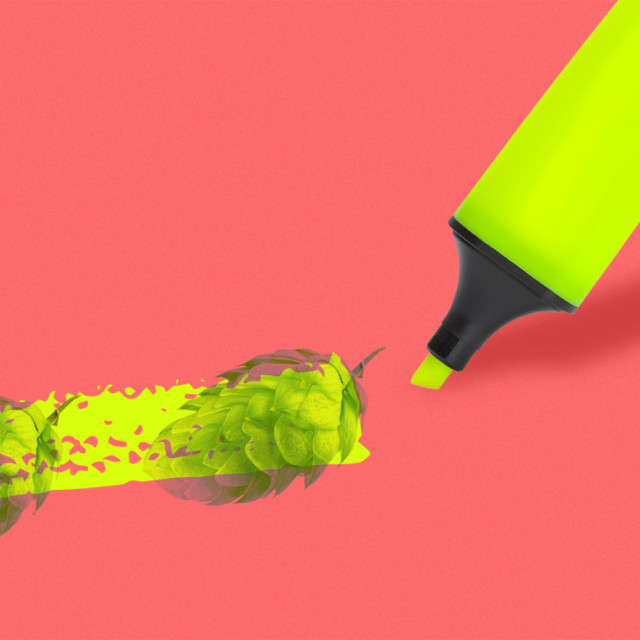If you were to try to chart the path that the India pale ale has taken in the United States over the last few decades, it would perhaps look a bit like the route taken by someone who had enjoyed a few too many in an evening. From its beginnings as a hop-forward and bitter ale, the category is now in many ways dominated by hazies, which often emphasize softness, creaminess, and explosive fruit character.
Although these hazy IPAs have made darlings of certain breweries (Other Half and Great Notion come to mind) while bringing new drinkers into the IPA fold, they’ve also prompted backlash from brewers and drinkers who feel that many modern techniques create intensity at the expense of balance and crispness. It’s exactly that sentiment — and maybe a bit of West Coast pride — that inspired Kevin Davey to create and brand a new IPA style. In his role as head brewer at Wayfinder Beer in Portland, Ore., he’s been leveraging his experience brewing lagers to create this new style: the cold IPA.
“The main intent was to create a beer that really highlights hops,” Davey says. “Not necessarily the fruity esters you get from the main strains of ale yeast, but the flavors of the hops themselves. That’s why we use a lager yeast, though we ferment much warmer than we would for a true lager.”
The use of lager yeast has caused some confusion and even anger among beer drinkers who insist that the cold IPA isn’t a new style of beer at all, but either an IPL (India pale lager) or simply an IPA made with lager yeast. Davey posits that neither of those descriptions quite fit: The beer is fermented at much too warm a temperature to be a true lager, and the entire recipe was built from the ground up to create this style. It’s far more than just applying a different yeast strain to an existing recipe.
Moreover, the use of adjuncts (typically rice or corn) to supplement the malted barley in the fermentation process is a crucial element of the cold IPA style. As Davey says, “This is maybe the most American way to brew, plus it gives the beer richness and texture while still allowing it to be totally dry.” It’s certainly one of the most obvious ways that the cold IPA reads as a reaction to the hazy IPA, recognizing that many hazy drinkers are drawn to that style’s creaminess and lush texture as much as the bold fruit flavors and potential sweetness.
The idea of a counterpoint to the hazy has resonated with brewers across the country ever since Davey pioneered it in 2017. Jude La Rose, co-owner of Chicago’s Hop Butcher For the World, has been a fan since he first encountered the beer at Wayfinder. “First off it was a brand-new style that was made differently than your other hoppy beers,” he says. “When [Kevin] explained it and we understood that it was going to lead to a different type of beer and experience, that was very exciting to us. Even if it has been done before, no one has ever explained to me their intent at all parts of the brewing process, and looked that closely into their ingredients. This style makes the cleanest of clean beers.”
Shaun O’Sullivan, co-founder and brewmaster at San Francisco’s 21st Amendment Brewery, has also brewed or collaborated on several different versions of cold IPAs over the last few years, and, like La Rose, he first encountered the style at Wayfinder, noting that there is an elegance to this style that’s approachable. “You don’t have to necessarily make a meal out of it, which can be the case with other IPA styles,” he says.
It’s important to remember that as dominant as the hazy IPA has been in recent years, trends inevitably create backlash and can prompt fatigue in drinkers. The fact that the term “hazy” eventually took over for the original “New England IPA” moniker shows just how useful that term is in conveying what a potential drinker could expect, something that Davey took note of when coming up with a name for this style. While “cold” might not be quite as evocative as “hazy,” it gets at a fundamental element of the style. “We got it right away, it just made sense to us,” LaRose says. “It was the purest, coldest, most crystalline expression of a hoppy beer that we’d ever had. In the end, we felt like it would allow us to make a beer that would drink like a hoppy beer but be cold and refreshing in a way that many IPAs are not.”
There’s no doubt that in a world saturated with IPA variants, breaking through the clutter can be challenging. As O’Sullivan notes, “The IPA category is vast: There are session IPAs, West Coast IPAs, triple IPAs, double IPAs, I could keep going.” He acknowledges that the cold IPA is a point along that continuum, but its name brings about a conversation, where brewers can explain that at the base this is a clean, clear hoppy beer that in some ways may be a reaction to heavier and more turbid hazy IPAs.
If the cold IPA can be the one variant that fuses some of what first popularized IPAs with the current love for smoothness and ease of access, then it just might become as ubiquitous as the West Coast IPAs it was inspired by and the hazy IPAs it’s a reaction to.
This story is a part of VP Pro, our free platform and newsletter for drinks industry professionals, covering wine, beer, liquor, and beyond. Sign up for VP Pro now!
